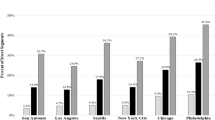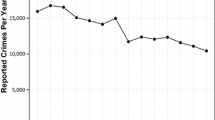Abstract
Objectives
To test the generalizability of previous crime and place trajectory analysis research on a different geographic location, Vancouver BC, and using alternative methods.
Methods
A longitudinal analysis of a 16-year data set using the street segment as the unit of analysis. We use both the group-based trajectory model and a non-parametric cluster analysis technique termed k-means that does not require the same degree of assumptions as the group-based trajectory model.
Results
The majority of street blocks in Vancouver evidence stable crime trends with a minority that reveal decreasing crime trends. The use of the k-means has a significant impact on the results of the analysis through a reduction in the number of classes, but the qualitative results are similar.
Conclusions
The qualitative results of previous crime and place trajectory analyses are confirmed. Though the different trajectory analysis methods generate similar results, the non-parametric k-means model does significantly change the results. As such, any data set that does not satisfy the assumptions of the group-based trajectory model should use an alternative such as k-means.



Similar content being viewed by others
Notes
Routine activity theory, geometric theory of crime, rational choice theory, and crime pattern theory.
For Vancouver, approximately 25 % of calls-for-services amongst the 22 index crimes examined from 1991 to 2006 were located at intersections and subsequently excluded from the analyses.
References
Andresen MA, Linning SJ (2012) The (in)appropriateness of aggregating across crime types. Appl Geogr 35(1–2):275–282
Andresen MA, Malleson N (2011) Testing the stability of crime patterns: implications for theory and policy. J Res Crime Delinq 48(1):58–82
Andruff H, Carraro N, Thompson A, Gaudreau P, Louvet B (2009) Latent class growth modelling: a tutorial. Tutor Quant Methods Psychol 5(1):11–24
Bernasco W, Block R (2011) Robberies in Chicago: a block-level analysis of the influence of crime generators, crime attractors, and offender anchor points. J Res Crime Delinq 48(1):33–57
Braga AA, Hureau DM, Papachristos AV (2011) The relevance of micro places to citywide robbery trends: a longitudinal analysis of robbery incidents at street corners and block faces in Boston. J Res Crime Delinq 48(1):7–32
Brantingham PJ, Brantingham PL (1991) Environmental criminology. Waveland Press, Prospect Heights
Brantingham PJ, Dyreson DA, Brantingham PL (1976) Crime seen through a cone of resolution. Am Behav Sci 20(2):261–273
Calinski T, Harabasz J (1974) A dendrite method for cluster analysis. Commun Stat 3(1):1–27
Elragal A, El-Gendy N (2012) Trajectory data mining and the need for semantics. European, Mediterranean and Middle Easter Conference on Information Systems, June 7–8, Munich, Germany
Farrell G, Tseloni A, Mailley J, Tilley N (2011) The crime drop and the security hypothesis. J Res Crime Delinq 48(2):147–175
Genolini C, Falissard B (2010) KmL: k-means for longitudinal data. Comput Stat 25(2):317–328
Groff ER, Weisburd D, Yang S (2010) Is it important to examine crime trends at a local “micro” level? A longitudinal analysis of street to street variability in crime trajectories. J Quant Criminol 26(1):7–32
Huizinga D, Esbensen F, Weiher AW (1991) Are there multiple paths to delinquency? J Crim Law Crim 82(1):83–118
Levitt SD (2004) Understanding why crime fell in the 1990s: four factors that explain the decline and six that do not. J Econ Perspect 18(1):163–190
Mishra S, Lalumière M (2009) Is the crime drop of the 1990s in Canada and the USA associated with a general decline in risky and health-related behavior? Soc Sci Med 68(1):39–48
Mowder MH, Cummings JA, McKinney R (2010) Resiliency scales for children and adolescents: profiles of juvenile offenders. J Psychoeduc Assess 28(4):326–337
Nagin DS, Land KC (1993) Age, criminal careers and population heterogeneity: specification and estimation of a nonparametric, mixed Poisson model. Criminology 31(3):327–362
Ouimet M (2002) Explaining the American and Canadian crime “drop” in the 1990s. Can J Criminol 44(1):33–50
Ratcliffe JH (2004) Geocoding crime and a first estimate of a minimum acceptable hit rate. Int J Geogr Inf Sci 18(1):61–72
Robinson WS (1950) Ecological correlations and the behavior of individuals. Am Sociol Rev 15(3):351–357
Sherman LW, Gartin PR, Buerger ME (1989) Hot spots of predatory crime: routine activities and the criminology of place. Criminology 27(1):27–56
Weisburd D, Bushway S, Lum C, Yang S (2004) Trajectories of crime at places: a longitudinal study of street segments in the City of Seattle. Criminology 42(2):283–322
Weisburd D, Bruinsma GJN, Bernasco W (2009a) Units of analysis in geographic criminology: historical development, critical issues, and open questions. In: Weisburd D, Bernasco W, Bruinsma GJN (eds) Putting crime in its place: units of analysis in geographic criminology. Springer, New York, pp 3–31
Weisburd D, Morris NA, Groff ER (2009b) Hot spots of juvenile crime: a longitudinal study of street segments in Seattle, Washington. J Quant Criminol 25(4):443–467
Weisburd D, Groff ER, Yang S (2012) The criminology of place: street segments and our understanding of the crime problem. Oxford University Press, New York
Author information
Authors and Affiliations
Corresponding author
Rights and permissions
About this article
Cite this article
Curman, A.S.N., Andresen, M.A. & Brantingham, P.J. Crime and Place: A Longitudinal Examination of Street Segment Patterns in Vancouver, BC. J Quant Criminol 31, 127–147 (2015). https://doi.org/10.1007/s10940-014-9228-3
Published:
Issue Date:
DOI: https://doi.org/10.1007/s10940-014-9228-3




